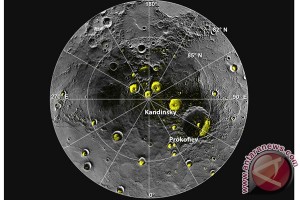 |
| Gambaran radar daerah kutub utara Merkurius |
Jakarta (ANTARA News) - The scientists who do observations with the help aircraft research MESSENGER find data that supports the old hypothesis that Mercury contains abundant water ice and other frozen volatile materials in the dark polar craters.
It is located adjacent to the Sun makes Mercury not seen as a place to find ice. But the slope of the axis of rotation is almost zero, less than one degree, so there is a bag on the planet's poles that never got sunlight.
Arrival at Mercury MESSENGER year brings new supporting evidence.
Overview of the Mercury Dual Imaging System were taken in 2011 and earlier this year confirmed that light-radar picture in Mercury's north and south poles are permanently dark, consistent with the hypothesis of the presence of water ice.
The article on page United States Space Agency (NASA) said that recent data indicate a strong MESSENGER ice water is the main component of Mercury's north polar sediments and that ice exposed at the surface in the cold sediments, buried beneath the dark material of the whole sediment.
Unlike NASA robotic vehicles, Curiosity, which took samples of soil and rock to find the right organic compounds, reflecting the MESSENGER probe laser, particle count, measure gamma rays, and collect data from orbit.
Es findings obtained by collecting data over a year based on computer modeling, laboratory testing and deduction, not a direct analysis.
MESSENGER's neutron spectrometer used to measure the levels of hydrogen, the Mercury Laser Altimeter (MLA) to measure the reflectance of Mercury's polar sediments and detailed model of the surface temperature of Mercury's north polar region using topographic data surface.
"Measurements show that the spatial distribution of the region with high-beam radar back in accordance with the predictions of the distribution of water ice is stable," said David Paige, a planetary scientist and the solar system from the University of California, Los Angeles, co-author of the findings.
Paige added, the dark material in the sediment poles of Mercury seems to be a mixture of organic compounds derived from comets and asteroids that have hit the planet, the same object may bring water to the deepest part of the planet.
(ANT)